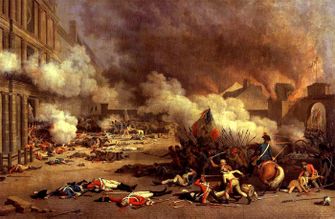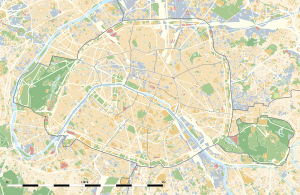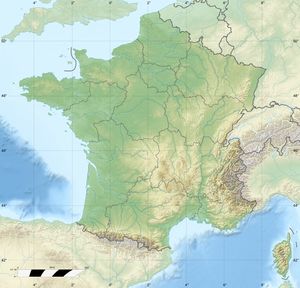10 أغسطس (الثورة الفرنسية)
| ||||||||||||||||||||||||||||||||
في 10 أغسطس 1792، أثناء الثورة الفرنسية، الميليشيا الفدرالية الثورية — بدعم من الحكومة المحلية الجديدة في باريس والتي اشتهرت "بالمتمردة" كوميونة باريس والمؤيدين من الحرس الوطني — قاموا بحصار قصر التويلري. احتمى الملك لويس السادس عشر والعائلة الملكية بالجمعية التشريعية. كان هذا دلالة على انتهاء نفوذ الملكية البوربونية الفرنسية (إلى أن استردته عام 1814، بالرغم من أن النظام الملكي في الامبراطورية كان قد أُدخل قبل عشر سنوات). النهاية الرسمية للملكية حدثت في الأسابيع الستة التالية، ضمن أول القررات الصادرة عن المؤتمر الوطني الجديد.
السياق
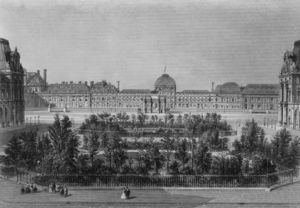 قصر التويلري، مقر لويس السادس عشر وقت التمرد. |
الوطن في خطر
في 11 يوليو أعلن الجمعية التشريعية بناء على مقترح قدمه جان دبري أن الوطن في خطر—"La patrie est en danger".[1]
التمرد
في 29 يوليو خطب روبسپيير في نادي اليعاقبة مطالبا - تحدّياً لدوق برونسفيك Brunswick - بسرعة الإطاحة بالملكية وتأسيس الجمهورية بإتاحة حق التصويت لجميع الرجال. وفي 30 يوليو انضم الممثلون الفدراليون القادمون من مارسيليا إلى وفود من دوائر (محافظات) أخرى لتقديم العون لعزل الملك. وفي 4 أغسطس وما تلاه أرسلت أحياء باريس، الحي إثر الحي Section مذكرات للجمعية التشريعية تفيد أنهم لم يعودوا يعترفون بالملك، وفي 6 أغسطس تم تقديم ملتمس لأعضاء الجمعية بضرورة عزل لويس عن العرش، لكن الجمعية التشريعية لم تتخذ إجراء ما، وفي 9 أغسطس نشر مارا Marat مناشدة للشعب يطالبه باجتياح قصر التويلري والقبض على الملك وأسرته والموظفين الملكيين الكبار كلهم باعتبارهم "خونة لا بد أن تضحي بهم الأمة أولا لتحقيق رفاهية الجماهير" وفي تلك الليلة قام الكومون (المجلس البلدي أو حكومة باريس) وكذلك مسئولو الأحياء بدق ناقوس الخطر لدعوة الجماهير إلى التجمع حول قصر التوليري في صباح اليوم التالي.
وحضر بعض الجماهير مبكرا جدا في الساعة الثالثة صباحا، وقبل الساعة السابعة كان خمسة وعشرون حيا (قسما) قد أرسلت العدد الذي سبق تحديده لها من الرجال المسلحين بالبندقيات (المسكت) والر ماح والسيوف، وأتى بعضهم بمدافع وانضم إليهم 800 من الممثلين الفدراليين وسرعان ما وصل عدد المحتشدين إلى تسعة آلاف، وكان يدافع عن القصر تسعمائه سويسري ومائتين من الحراس الآخرين، ورغبة من لويس في تهدئة الهياج فإنه قاد أسرته من الغرف الملكية إلى مسرح القصر حيث كانت الجمعية التشريعية في دورة انعقاد مضطربة، وقال الملك: "لقد أتيت إلى هنا لأمنع جريمة كبرى"(91).
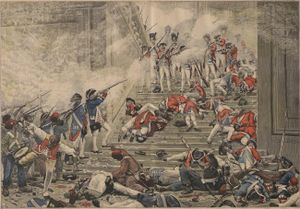 مذبحة الحراس السويسريون. |
وسمح للمتمردين بدخول ساحة القصر، وعند بداية الدرج المؤدي إلى غرف النوم الملكية منع الحرس السويسري المتمردين من التقدم إلا أن الجماهير الحاشدة ضغطت، فأطلق السويسريون النار فقتلوا أكثر من مائة رجل وامرأة، فأرسل الملك أوامره إلى الحرس السويسري بوقف إطلاق النار والانسحاب، فنفذوا الأوامر لكن المحتشدين وعلى رأسهم الممثلون الفدراليون لمارسيليا اجتاحوهم وتم ذبح معظم أفراد هذا الحرس السويسري كما جرى القبض على كثيرين منهم تم اقتيادهم إلى دار البلدية حيث أعدموا.[2]
وجرى ذبح الخدم - بمن فيهم العاملون في المطبخ - في مهرجان دموي مجنون. وأنشد أهل مرسيليا نشيد المرسييز بمصاحبة عزف على البيانو القيثاري (الهاربسكورد) الخاص بالملكة، واستراحت العاهرات اللائي اعتراهن التعب فوق سرير الملكة، وأحرق المتمردون الأثاث وأراقوا النبيذ، وبالقرب من ساحة الفروسية أشعل الجمهور السعيد النار في تسعمائة مبنى وأطلقوا النار على رجال الإطفاء الذين أتوا لإخماد النيران. واستعرض بعض المنتصرين بأعلامهم التي صنعوها من السترات الحمراء لأفراد الحرس السويسري المقتول - وبذلك كانت هذه أول حالة معروفة لاستخدام العلم الأحمر رمزاً للثورة.
نهاية الجمعية التشريعية
وحاولت الجمعية التشريعية إنقاذ الأسرة المالكة، لكن مقتل عدد من أعضائها على أيدي الجماهير الغازية، أقنع الباقين بتسليم اللاجئين إليها من الأسرة المالكة لكومون باريس ليكونوا تحت تصرفه، فجرى التحفظ عليهم بعناية تحت حراسة صارمة في المعبد the Temple - وهو دير قديم حصين لجماعة الفرسان الداويين (رهبان وجنود في الوقت نفسه) واستسلم لويس بلا مقاومة حزينا على زوجته التي وخط الشيب - الآن - مفرقها، وعلى ابنه المريض، وراح ينتظر النهاية بصبر.
التبعات
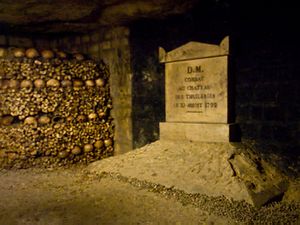 Plaque commemorating the 10 August 1792 assault on the Tuileries, in the Catacombs of Paris where many of those killed have been buried directly. |
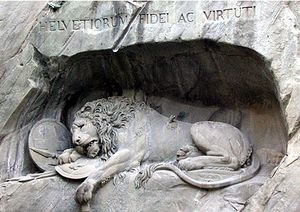
Text reads: HELVETIUM FIDEI AC VIRTUTI (To the loyalty and bravery of the Swiss)
The crisis of the summer of 1792 was a major turning-point of the Revolution. By overthrowing the monarchy, the popular movement had effectively issued a challenge to the whole of Europe; internally, the declaration of war and overthrow of the monarchy radicalized the Revolution. If the Revolution was to survive it would have to call on all of the nation's reserves.[3]
A second revolution had, indeed, occurred, ushering in universal suffrage for men and, in effect, a republic. However, it did not have the warm and virtually unanimous support that the nation had offered the first. Events since 1789 had brought difference and divisions: many had followed the refractory priests; of those who remained loyal to the revolution some criticized 10 August while others stood by, fearing the day's aftermath. Those who had participated in the insurrection or who approved it were few in number, a minority resolved to crush counter-revolution by any means.[4]
Among the Swiss Guards who survived the insurrection, up to 350 later joined the Revolutionary Army of the First French Republic (although this total also included discharged soldiers of the twelve Swiss line infantry regiments in French service), while others joined the counter-revolutionaries in the War in the Vendée. In 1817, the Swiss Federal Diet awarded 389 of the survivors with the commemorative medal Treue und Ehre (Loyalty and Honor).[5]
المجلس التشريعي
Over half of the Legislative Assembly's members fled and on the evening 10 August only 284 deputies were in their seats.[6] The Assembly looked on anxiously at the vicissitudes of the struggle. So long as the issue was doubtful, Louis XVI was treated like a king. As soon as the insurrection was definitely victorious, the Assembly announced the suspension of the King. The King was placed under a strong guard. The Assembly would have liked to assign him the Luxembourg Palace, but the insurgent Commune demanded that he should be taken to the Temple, a smaller prison, which would be easier to guard.[7]
14 July had saved the Constitutional Assembly, 10 August passed sentence on the Legislative Assembly: the day's victors intended to dissolve the Assembly and keep power in their own hands. But because the new Commune, composed of unknowns, hesitated to alarm the provinces, the Girondins were kept and the Revolution was mired in compromise. The Assembly remained for the time being but recognized the Commune, increased through elections to 288 members. The Assembly appointed a provisional Executive Council and put Monge and Lebrun-Tondu on it, along with several former Girondin ministers. The Assembly voted that the Convention should be summoned and elected by universal suffrage to decide on the future organization of the State.[8] One of its first acts was to abolish the monarchy.[9]
التغيرات الاجتماعية
With the fall of the Tuileries, the face of Parisian society underwent an abrupt change. The August insurrection greatly increased sans-culotte influence in Paris. Whereas the old Commune had been predominantly middle class, the new one contained twice as many artisans as lawyers—and the latter were often obscure men, very different from the brilliant barristers of 1789. Moreover, the Commune itself was little more than "a sort of federal parliament in a federal republic of 48 states". It had only a tenuous control over the Sections, which began practicing the direct democracy of Rousseau. "Passive" citizens were admitted to meetings, justices of the peace and police officers dismissed and the assemblée générale of the Section became, in some cases, a "people's court", while a new comité de surveillance hunted down counter-revolutionaries. For the Parisian nobility, it was 10 August 1792 rather than 14 July 1789 that marked the end of the ancien régime.[6]
The victors of 10 August were concerned with establishing their dictatorship. The Commune silenced the opposition press, closed the toll gates, and seized a number of refractory priests and aristocratic notables. On 11 August the Legislative Assembly gave municipalities the authority to arrest suspects.[10] The volunteers were preparing to leave to the front and the rumours spread rapidly that their departure was to be the signal for prisoners to stage an uprising. The wave of executions in prisons followed, what later was known as The September Massacres.[11]
الحرب
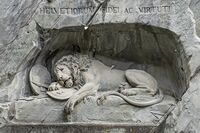
Text reads: HELVETIORUM FIDEI AC VIRTUTI (To the loyalty and bravery of the Swiss)
To convince the revolutionaries that the insurrection of 10 August had decided nothing, the Prussian army crossed the French frontier on the 16th. A week later the powerful fortress of Longwy fell so quickly that Vergniaud declared it to "have been handed over to the enemy." By the end of the month the Prussians were at Verdun, the last fortress barring the road to Paris. In the capital, there was a well-justified belief that Verdun would offer no more than a token resistance. The war, which had appeared to bring the triumph of the Revolution, now seemed likely to lead it to disaster.[12]
On 2 September the alarm gun was fired and drums beat the citizens to their Sections again. The walls of Paris were plastered with recruiting posters whose opening sentence, "To arms, citizens, the enemy is at our gates!" was taken literally by many readers. In the Assembly, Danton concluded the most famous of all his speeches: "De l’audace, encore de l’audace, toujours de l’audace, et la France est sauvée!" (Audacity, and yet more audacity, and always audacity, and France will be saved!) Once more the sans-culottes responded and in the next three weeks, 20,000 marched from Paris for the defence of the Revolution.[13]
انظر أيضاً
- الجمعية التشريعية وسقوط الملكية الفرنسية، لسياق تاريخي أكثر تفصيلاً.
الهامش
- ^ "La révolution française: Les Girondins: :La patrie en danger"
- ^ ديورانت, ول; ديورانت, أرييل. قصة الحضارة. ترجمة بقيادة زكي نجيب محمود.
- ^ McPhee 2002, p. 98.
- ^ Lefebvre 1962, p. 234.
- ^ 10 أغسطس (الثورة الفرنسية) in German, French and Italian in the online Historical Dictionary of Switzerland.
- ^ أ ب Hampson 1988, p. 148.
- ^ Mathiez 1929, p. 159.
- ^ Lefebvre 1962, p. 238.
- ^ Thompson 1959, p. 315.
- ^ Lefebvre 1962, p. 235.
- ^ Soboul 1974, p. 262.
- ^ Hampson 1988, p. 151.
- ^ Hampson 1988, p. 152.
- قالب:Mignet
- Mignet, in turn, cites Pierre Louis Roederer، Chronique des Cinquante Jours, and refers to him as "a writer of the most scrupulous accuracy".
وصلات خارجية
- The document by which the National Assembly formally deposed Louis XVI and called for the Convention, translated into English.
